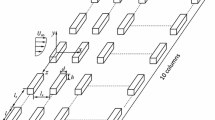Abstract
Turbulence in the flow impacts the peak pressure on buildings by more than 100% in certain locations, and in the same way, it impacts many phenomena in several industrial applications. Understanding turbulence will improve the process of computing peak pressure on buildings. In this work, methods to identify the turbulence structure are reviewed. Then, Q-criterion, vorticity in z, and magnitude of vorticity are used to evaluate the turbulence structure developed using inflow turbulence generators based on random Fourier method (NSRFG and CSDE) and precursor method. Iso-surfaces and contours on planes are used to visualize the turbulence structure.
Access this chapter
Tax calculation will be finalised at checkout
Purchases are for personal use only
Similar content being viewed by others
References
Kajishima, T., Taira, K.: Computational Fluid Dynamics: Incompressible Turbulent Flows. Springer (2017)
Selvam, R.P.: Computational Fluid Dynamics for Wind Engineering. Wiley-Blackwell, Chichester (2022)
Versteeg, H., Malalasekera, W.: An Introduction to Computational Fluid Dynamics: The Finite Volume Method, 2nd edn. Pearson (2007)
Mansouri, Z., Selvam, R.P., Chowdhury, A.G.: Maximum grid spacing effect on peak pressure computation using inflow turbulence generators. Results Eng. 15, 100491 (2022)
Mansouri, Z., Selvam, R.P., Chowdhury, A.G.: Performance of different inflow turbulence methods for wind engineering applications. J. Wind Eng. Ind. Aerodyn. 226, 105141 (2022)
Orlandi, P.: Fluid Flow Phenomena: A Numerical Tool Kit. Kluwer Academic Publishers (2001)
Dhamankar, N., Blaisdell, G., Lyrintzis, A.: Overview of turbulent inflow boundary conditions for large-eddy simulations. AIAA J. 56, 1–18 (2017)
Wu, X.: Inflow turbulence generation methods. Annu. Rev. Fluid Mech. 49, 23–49 (2017)
Yu, Y., Yi Yang, Y., Xie, Z.: A new inflow turbulence generator for large eddy simulation evaluation of wind effects on a standard high-rise building. Build. Environ. 138, 300–313 (2018)
Selvam, R.P., Chowdhury, A., Irwin, P., Mansouri, Z., Moravej, M.: CFD peak pressures on TTU building using continuity satisfied dominant waves (CSDW) method as inflow turbulence generator. Report, Department of Civil Engineering, University of Arkansas (2020)
Shi, L., Yeo, D.: Large eddy simulations of model-scale turbulent atmospheric boundary layer flows. J. Eng. Mech. 143(9), 06017011 (2017)
Yeo, D., Shi, L.: Chapter 9: Computational versus wind tunnel simulation of atmospheric boundary layer flow for structural engineering applications. In: Wind Engineering for Natural Hazards: Modeling, Simulation and Mitigation of Windstorm Impact on Critical Infrastructure, pp. 169–191. ASCE (2018)
Sengupta, T., Sharma, P.K.: Chapter 2: Space-time resolution for transitional and turbulent flows. In: Pirozzoli, S., Sengupta, T.K. (eds.) High-Performance Computing of Big Data for Turbulence and Combustion CISM International Centre for Mechanical Sciences, vol. 592, pp. 31–54. Springer, Cham (2019)
Hunt, J.C.R., Wray, A.A., Moin, P.: Eddies, streams, and convergence zones in turbulent flows. In: Proceedings of the Summer Program 1988, CTR Report Stanford University, pp. 193–208. Center for Turbulence Research, Stanford (1988)
Jeong, J., Hussain, F.: On the identification of a vortex. J. Fluid Mech. 332, 339–363 (1995)
Sengupta, A., Suman, V.K., Sengupta, T.K., Bhaumik, S.: An enstrophy-based linear and nonlinear receptivity theory. Phys. Fluids. 30(5), 054105 (2018)
Sengupta, T.K., De, S., Sarkar, S.: Vortex-induced instability of an incompressible wallbounded shear layer. J. Fluid Mech. 493, 277–286 (2003)
Author information
Authors and Affiliations
Corresponding author
Editor information
Editors and Affiliations
Rights and permissions
Copyright information
© 2024 The Author(s), under exclusive license to Springer Nature Switzerland AG
About this paper
Cite this paper
Panneer Selvam, R. (2024). Turbulence Generators and Turbulence Structure. In: Kamalov, F., Sivaraj, R., Leung, HH. (eds) Advances in Mathematical Modeling and Scientific Computing. ICRDM 2022. Trends in Mathematics. Birkhäuser, Cham. https://doi.org/10.1007/978-3-031-41420-6_24
Download citation
DOI: https://doi.org/10.1007/978-3-031-41420-6_24
Published:
Publisher Name: Birkhäuser, Cham
Print ISBN: 978-3-031-41419-0
Online ISBN: 978-3-031-41420-6
eBook Packages: Mathematics and StatisticsMathematics and Statistics (R0)




